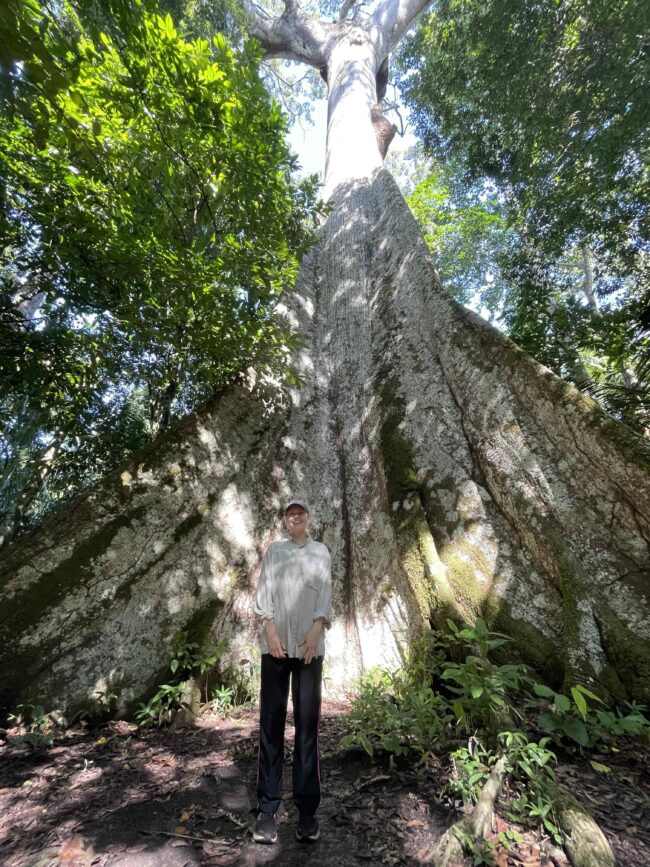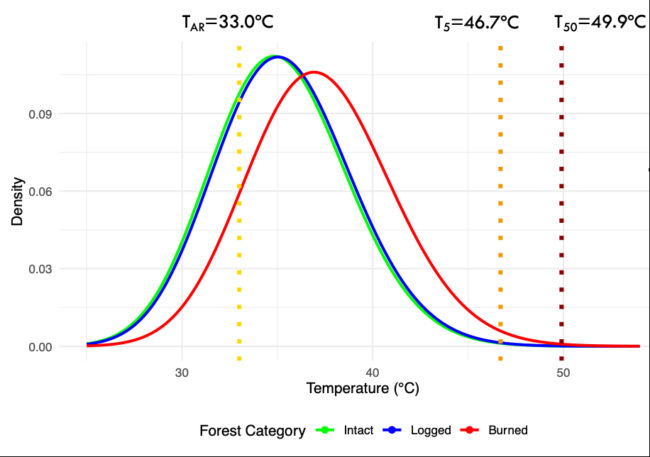
Forests in the Brazilian Amazon damaged by fire remain about 2.6 °C (4.7 °F) hotter than neighboring intact or selectively logged stands, and the extra heat can linger for at least 30 years. The findings suggest that fire alters tropical forests in ways that slow their recovery and may weaken their ability to tolerate climate stress and store carbon—a crucial role these forests play in global climate mitigation.
The study was published today in the journal Environmental Research Letters.
“We’re finding that burning has major ecological impacts over large timescales and that regeneration is much more at risk—it’s slower or not happening at all,” said lead author Savannah S. Cooley, a research scientist at NASA Ames Research Center and a recent PhD graduate of Columbia’s Ecology, Evolution and Environmental Biology (E3B) program. (Cooley was co-advised by Duncan Menge and Ruth DeFries, professor and co-founding dean of the Columbia Climate School.)
Unlike fire-adapted ecosystems such as savannas or pine forests, Amazon rainforests evolved in humid conditions where natural fires were rare. As a result, many tropical tree species haven’t developed traits to tolerate or recover from fire damage.
In addition to being hotter on average, burned forests in the study area were more thermally unstable. Compared to selectively logged or intact forests, they experienced greater daily temperature fluctuations and were more likely to cross physiological thresholds that impair tree function. During peak dry season heat, nearly 87% of leaves exposed to sunlight in burned forests lose more energy from respiration than they gain from photosynthesis, compared to 72–74% in selectively logged or intact stands.
Burned forests were also 10 times more likely to cross the threshold for lasting damage.

for the warmest patches (top quartile) are shown.
These temperature differences reflect fundamental changes in forest structure that leave burned areas more vulnerable to heat. Fires thin the upper canopy, remove mid- and lower-level vegetation and reduce leaf area, decreasing shade and the transpiration that typically cool a forest. Fewer leaves enable sunlight to heat exposed surfaces and air near the canopy. Burns also create edges next to cleared land, allowing warmer air to move inward. The forest retains this extra heat until its vegetation layers rebuild, a process that can take decades.
The study suggests fire is the primary driver of prolonged heat stress in degraded Amazon forests. In areas where selective logging left the canopy mostly intact, temperatures were similar to those of undisturbed forests. The contrast highlights fire prevention and low-impact logging as key strategies for maintaining the health of tropical forests.
Insights from Space
The study is based on satellite imagery of Feliz Natal Municipality in Brazil’s Arc of Deforestation, a region in the southeastern Amazon where fire and logging have accelerated since the 1980s. The researchers conducted the first systematic thermal comparison of burned, selectively logged, and intact forests in the area using integrated satellite observations. They combined three years of land surface temperature data from NASA’s ECOSTRESS instrument with 3D canopy structure data from the GEDI lidar mission, an analysis that drew on more than 6,700 matched observations collected during the Amazon dry season.
Using a hierarchical model, the team integrated temperature and structure data to track how often sunlit leaves exceeded thresholds for photosynthesis slowdown or tissue damage. Factoring in canopy height and time since disturbance, they reconstructed long-term thermal recovery across forest layers. The result is a unique, leaf-level view of how long heat stress persists after disturbance and how forest structure influences thermal vulnerability over time.
Hidden heat reveals new risks for restoration and resilience
The findings provide nuance to the understanding of how climate policy addresses tropical forest degradation. Carbon mitigation and forest restoration strategies often treat degraded forests as a single category. However, the study reveals that fire has longer-lasting thermal impacts that aren’t detectable by conventional optical satellite images alone. In optical satellite images, fire-damaged forests may appear to have regrown, but many still experience elevated heat stress.
The distinction matters because tropical forests remove large amounts of carbon dioxide from the atmosphere each year and are a key component of global restoration and offset programs. If fire-damaged forests remain thermally stressed for decades, the carbon benefits of passive regrowth may be overstated. Incorporating physiological heat data can provide a more realistic assessment of forest function in climate strategies.
While the findings highlight challenges, Cooley said meaningful action is possible.
“Degraded tropical ecosystems, especially burned forests, are experiencing thermal stress,” she said. “But there’s a lot we can do to minimize the damage to biodiversity and to the species that are experiencing this stress—both in terms of forest management, by helping to reduce fires in the Amazon, and on the carbon mitigation side, by continuing to cut emissions aggressively and rapidly, and transitioning to a sustainable and clean energy economy.”
The study’s coauthors are Duncan N. L. Menge, Columbia University; Michael Keller, USDA Forest Service and NASA Jet Propulsion Laboratory; Kerry Cawse-Nicholson, NASA Jet Propulsion Laboratory; Marcos Longo, Lawrence Berkeley National Laboratory; André P. Dias, Secretaria de Estado de Meio Ambiente; Vinicius Silgueiro and Raquel Carvalho, Instituto Centro de Vida; Ovidiu Csillik, Wake Forest University; Doug Anderson, Micah Gilbreath, and Paul Duffy, Neptune and Company, Inc.; and Marcos Adami, Instituto Nacional de Pesquisas Espaciais.


